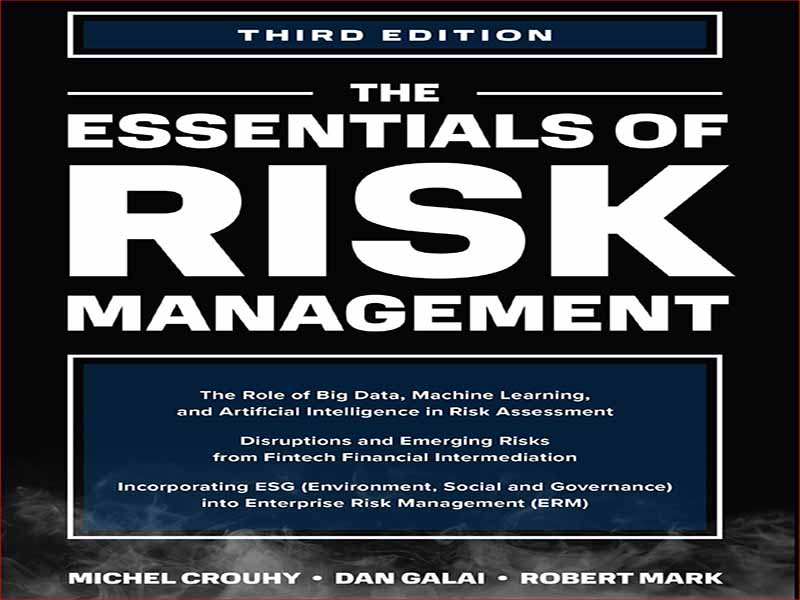- عنوان کتاب: THE ESSENTIALS OF RISK MANAGEMENT
- نویسنده/انتشارات: Michel Crouhy
- حوزه: مدیریت امنیت اطلاعات
- سال انتشار: 2023
- تعداد صفحه: 681
- زبان اصلی: انگلیسی
- نوع فایل: pdf
- حجم فایل: 18.2 مگابایت
نیم دوجین سال و بیشتر از آغاز بحران مالی جهانی 2007-2009 می گذرد، و حتی بحران بدهی دولت اروپا در سال 2010 در حال محو شدن در تاریخ است. در هیچ یک از این دو مورد نمی توان مطمئن بود که بحران ها به طور کامل حل شده اند و پس لرزه ها و پیامدهای آن همچنان به شکل گیری جهان ما ادامه می دهند. با این حال، ممکن است زمان کافی برای جذب درسهای اصلی سالهای بحران و درک پیامدهای اصلاحات هنوز در حال ظهور در صنایع مالی جهان سپری شده باشد. در این [ویرایش دوم] اصول مدیریت ریسک، ما هر فصل را با توجه به آنچه از شکستهای مدیریت ریسک در طول سالهای بحران آموختهایم، بازبینی کردهایم، و در این مقدمه، از زمانی که اولین مقاله را منتشر کردیم، روندهای کلیدی در مدیریت ریسک را انتخاب میکنیم. با این حال، ما همچنین سعی کردهایم از تسلط بیش از حد کتاب بهعنوان یک کل تحت سلطه رویدادهای خارقالعاده 2007–2009 و سالهای بعدی بلافاصله جلوگیری کنیم. برخی از درسهایی که در آن سالها آموخته شد، درسهایی بود که بحرانهای قبلی قبلاً به مدیران ریسک آموخته بود، و در چاپ اول کتاب با جزئیاتی به آن پرداخته شد – حتی اگر برخی از شرکتها به سختی آنها را عملی کردند. سالهای بحران همچنین باعث ایجاد یک سری اصلاحات اساسی در مقررات موسسات مالی شد، و یک چیزی که میتوانیم در مدیریت ریسک از آن مطمئن باشیم این است که تغییرات ساختاری عمده محیطهای تجاری جدیدی ایجاد میکند که به نوبه خود رفتار تجاری و ریسک را تغییر میدهد. یکی از نفرینهای مدیریت ریسک این است که همیشه سعی میکند تا آخرین بحران را بهجای اعمال اولین اصول مدیریت ریسک برای جلوگیری از بحران بعدی – تلهای که ما سعی کردهایم از آن اجتناب کنیم- مدیریت کند. امیدواریم این کتاب به تلاش برای تقویت چارچوب کلی مدیریت ریسک با تشویق ترکیب مناسبی از تخصص نظری، دانش رویدادهای اخیر و گذشته و کنجکاوی در مورد آنچه که ممکن است روندهای ریسک امروز را هدایت کند، کمک کند. بحران مالی که در تابستان 2007 آغاز شد، اوج رونق استثنایی در رشد اعتبار و اهرم در سیستم مالی بود که از زمان بحران اعتباری قبلی در سالهای 2001-2002 ایجاد شده بود، که توسط یک سیاست پولی تطبیقی تحریک شده بود. این رونق با یک دوره طولانی از شرایط اقتصادی و مالی خوشخیم، از جمله نرخهای بهره واقعی پایین و نقدینگی فراوان، تغذیه شد که وامگیرندگان، سرمایهگذاران و واسطهها را تشویق کرد تا در معرض خطر و اهرم خود قرار بگیرند. سالهای رونق نیز با موجی از نوآوریهای مالی مرتبط با اوراق بهادار همراه بود، که ظرفیت سیستم مالی برای تولید داراییهای اعتباری را افزایش داد اما از ظرفیت آن برای مدیریت ریسکهای مرتبط پیشی گرفت. پویایی: شکست مدیریت ریسک و سیستمهای جبران ضعیف در موسسات مالی، شکست در شفافیت و افشا و بسیاری موارد دیگر. در سالهای پس از بحران، بسیاری از زمینههای ضعف از طریق مقررات و از بالاترین نهادهای مالی (هیئت مدیره و کمیته مدیریت) گرفته تا شیوههای خط کسبوکار، از جمله ناهماهنگی انگیزهها بین کسبوکار، شروع به رسیدگی شده است. و سهامداران، دارندگان اوراق قرضه و سرمایه گذاران آن. در زیر، برخی از مشکلات عمده کشف شده توسط بحران مالی جهانی را خلاصه می کنیم. بقیه کتاب با جزئیات بیشتری به این مسائل می پردازد.
Half a dozen years and more have passed since the start of the global financial crisis of 2007–2009,1 and even the European sovereign debt crisis of 2010 is fading into history. In neither case can we be sure that the crises are fully resolved, and their aftershocks and ramifications continue to shape our world. However, enough time may have elapsed for us to absorb the main lessons of the crisis years and to begin to understand the implications of the still unfolding reforms of the world’s financial industries. In this [second edition] of The Essentials of Risk Management we have revisited each chapter in light of what has been learned from risk management failures during the crisis years, and in this Introduction we pick out key trends in risk management since we published the first edition in 2006. However, we have also tried to prevent the book as a whole becoming too dominated by the extraordinary events of 2007–2009 and the immediate succeeding years. Some of the lessons learned in those years were lessons that earlier crises had already taught risk managers, and that were covered in some detail in the first edition of the book—even if some firms found it hard to put them into practice. The crisis years also spawned a series of fundamental reforms of the regulation of financial institutions, and one thing we can be sure of in risk management is that major structural change creates new business environments, which in turn transform business behavior and risk. One of the curses of risk management is that it perennially tries to micromanage the last crisis rather than applying the first principles of risk management to forestall the next—a trap we have tried to avoid. We hope this book contributes to the attempt to strengthen the overall framework of risk management by encouraging the right mix of theoretical expertise, knowledge of recent and past events, and curiosity about what might be driving risk trends today. The financial crisis that started in the summer of 2007 was the culmination of an exceptional boom in credit growth and leverage in the financial system that had been building since the previous credit crisis in 2001–2002, stimulated by an accommodative monetary policy. The boom was fed by an extended period of benign economic and financial conditions, including low real interest rates and abundant liquidity, which encouraged borrowers, investors, and intermediaries to increase their exposure in terms of risk and leverage. The boom years were also marked by a wave of financial innovations related to securitization, which expanded the capacity of the financial system to generate credit assets but outpaced its capacity to manage the associated risks.2 The crisis uncovered major fault lines in business practices and market dynamics: failures of risk management and poorly aligned compensation systems in financial institutions, failures of transparency and disclosure, and many more. In the years following the crisis, many areas of weakness have begun to be addressed through regulation and from the very top of financial institutions (the board of directors and the management committee) down to business line practices, including the misalignment of incentives between the business and its shareholders, bondholders, and investors. Below, we summarize some of the major problem areas uncovered by the global financial crisis; the rest of the book addresses these issues in more detail.
این کتاب را میتوانید از لینک زیر بصورت رایگان دانلود کنید:
Download: THE ESSENTIALS OF RISK MANAGEMENT



































نظرات کاربران